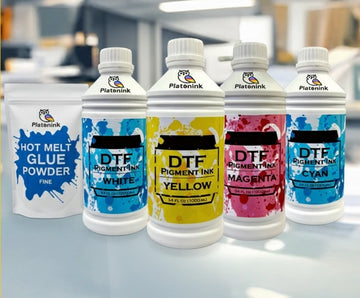You're not the first person who has ever peeled back your DTF transfer and seen a hazy shadow effect or a faint duplicate image. One of the most annoying problems for printers is ghosting in DTF transfers. It can destroy an otherwise flawless print, wasting time, money, and the trust of the client.
The good news is that ghosting can be prevented.
This blog post will explain the reasons behind DTF transfer ghosting fix, how to prevent it, and, above all, how to resolve it.
What Is Ghosting in DTF Transfers?
Ghosting in DTF transfers refers to a faint duplicate or blurry shadow that appears beside your design. It looks like your image was printed twice with a slight shift.
This unwanted effect can appear in:
- Letters and outlines
- High contrast areas
- Detailed graphic edges
The ghost effect in DTF printing not only reduces the quality of your work but can lead to dissatisfied customers and reprints.
Common Causes of Ghosting in DTF Transfers
- DTF Heat Press Alignment Issues: Misalignment between your film and garment during pressing can shift the transfer slightly, creating a double image.
- Too Much Pressure or Movement: Applying excessive pressure or accidentally moving the film mid press can lead to ghosting. This is a common DTF transfer printing mistakes.
- Inconsistent Temperature or Time: Overheating or underheating can affect how the adhesive melts. Combined with incorrect press duration, it can cause a partial lift and shift of the design.
- Static or Film Curling: Film that curls or lifts before the press opens can shift slightly, causing ghosting.
- Improper Curing of the Powder: If your adhesive powder isn’t fully cured or is overbaked, it may create uneven sticking or soft spots, leading to dtf print alignment issues during pressing.
How to Fix Ghosting in DTF Transfers
Let’s look at some practical DTF ghosting troubleshooting tips:
Check Your Heat Press Settings
- Follow the suggested temperature and duration, which is usually 290 to 320°F for 10 to 15 seconds.
- Test the pressure using a pressure gauge or paper pull test.
Secure the Film Before Pressing
- Use heat resistant tape to keep the DTF transfer film in place.
- Avoid opening the press too quickly, which may cause a shift.
Double Check Alignment
- Ascertain that the film is securely positioned and that your outfit is centered.
- A ruler or T square might be useful for precise placement.
Let the Press Cool Before Reopening (For Cold Peel)
- If using cold peel film, allow the transfer to cool down completely before peeling.
- Premature lifting can create a double image effect.
Use Anti Static Measures
-
Anti static spray or grounding your press can prevent unwanted film movement.
Preventing Ghosting: Best Practices
Prevention is always better than repair. Here’s how to avoid dtf ghosting:
- Consistent Pressing Routine: Avoid sudden jerks or fast movements.
- Use High Quality Film and Powder: Inferior materials are prone to curl and static.
- Proper Pre Pressing: Pre press garments for 2 to 5 seconds to remove moisture and flatten fabric.
- Label Your Settings: Keep a settings sheet near your heat press for each fabric type.
Conclusion
Although it may be a frequent issue, ghosting in DTF transfers need not be your standard. You can consistently produce prints that are clear, sharp, and of expert quality if you have the correct equipment, settings, and attention to detail.
Keep in mind that even little process improvements result in better outcomes and more satisfied clients.
And if you ever need premium DTF supplies to reduce the chance of dtf print ghosting issueghost effect in DTF prints, visit Bostonian DTF, we’re here to help make every press perfect.
Frequently Asked Questions
1. What causes ghosting in DTF transfers?
Ghosting is usually caused by misalignment, excess movement during pressing, static issues, or incorrect temperature and pressure settings.
2. How can I fix ghosting on a DTF print?
Double check your alignment, secure the film with heat tape, adjust press settings, and ensure proper curing of adhesive powder to prevent shifting.
3. Will ghosting go away after washing?
No, ghosting is a permanent defect in the print and will not wash out. It’s best to catch and fix the issue before pressing.
4. What’s the best way to avoid ghosting in DTF printing?
Prevent film movement, use proper press settings, handle transfers carefully, and always test your equipment regularly to catch errors early.
5. Can ghosting occur with hot peel or cold peel DTF?
Yes. Both hot and cold peel films can ghost if not handled correctly. Follow curing and peel instructions closely for each film type.


















